|
|
New dual-stage air bags part of some 2000 autos
By CATHERINE STRONG
THE ASSOCIATED PRESS
WASHINGTON (AP) -- At car dealers this fall: new, more sophisticated air bags that adjust their force of inflation to the severity of a crash to protect passengers better.
It's no longer just a high-tech concept. So-called dual-stage air bags are on the 2000 models of some luxury cars and several of the nation's most popular family cars -- the Ford Taurus and Honda Accord.
Safety experts say the new technology will reduce deaths and injuries from air bags that inflated explosively, prompting a public outcry.
In serious crashes, when passengers need the devices' full power to cushion them, the new bags inflate with about the same force as those in 1999 model cars. But in lower speed crashes, the air bags pop open with at least 20 percent less force.
A sensor in the front of the car detects the severity of a crash by calculating the change of velocity that occurs when another object, such as a car, crashes into it. Another sensor registers whether a front seat belt is buckled. If a belt is being used, the full force of the air bag is delayed until a higher speed when it is needed.
"Today in cars we have a one-bag-fits-all mentality. This changes all that," says Stephen Kozak, a Ford engineer who oversaw the Taurus system's development.
Government officials, automakers, insurers and safety advocacy groups agree the new technology will reduce air bag deaths and injuries -- particularly of young children and shorter adults -- in low-speed crashes.
"It reduces the risk (of deaths and injuries) dramatically in better tailoring the air bag inflation to the crash," said Dr. Ricardo Martinez, head of the National Highway Traffic Safety Administration.
Air bags have been blamed for at least 145 deaths -- mostly children and shorter women -- in low-speed crashes the victims otherwise should have survived, federal safety regulators say. Air bags also have saved an estimated 4,600 lives in higher-speed crashes.
Ford Motor Co. has the dual-inflation air bags on both the driver and passenger side of its model year 2000 Taurus, the third-best-selling car nationwide. Honda Motor Co. has them on just the passenger side of its 2000 Accords. The Accord is the second-best-selling car.
The decision by Ford and Honda to put the technology on their top-selling family cars as standard equipment means that for the first time advanced air bags are reaching large numbers of American families. The automakers say they plan eventually to expand the system to other vehicles.
"You're going to see this technology spread very rapidly," said Brian O'Neill of the Insurance Institute for Highway Safety.
Several luxury automakers also have dual-stage air bags on some 2000 models, such as the Mercedes-Benz S-class sedans and BMW 3-, 5- and 7-series sedans, but all those models sell in much smaller numbers because of their high costs. Some Honda Acuras had a dual-stage bag for the 1999 model year.
Automakers declined to discuss the new technology's price.
Toyota, which makes the Camry, the nation's best-selling car last year -- has not announced plans for dual-stage air bags; neither have other major automakers in the United States -- General Motors and DaimlerChrysler AG.
But GM spokesman Terry Rhadigan said: "It's no secret that we and everyone else are working on that. It's the wave of the future."
|

Better air bags
These automobiles have dual-stage air bags in their 2000 models that inflate at two different force levels based on the severity of a crash and whether a passenger is wearing a seat belt:
Ford Motor Co. has the dual-inflation air bags on the driver and passenger side of its model year 2000 Taurus, the third-best-selling car nationwide. Ford put the system on the driver's side to help short adults who sit close to the steering wheel and are more likely than other adults to be injured by the air bag. A sensor detects whether the driver's seat track is nearly or all the way forward and signals the air bag to always deploy the first, softer stage in crashes.
Honda Motor Co. has one on the passenger side of its 2000 Accords. The Accord is the second-best-selling car. Honda is focusing on the passenger side because that is where children -- the most vulnerable population -- have suffered serious injuries.
BMW has dual-stage air bags for the 2000 model year on the driver and passenger side in the 5- and 7-series sedans, the 3-series sedan and coupe. The system also can detect if a front-seat passenger is belted or unbelted. If nobody is in the passenger seat, the air bag will not deploy.
Mercedes-Benz has dual-stage air bags on the front passenger side of the 2000 S-class cars and the CL coupe. For years, Mercedes has been able to detect whether a passenger is wearing a seat belt and reserve the firing of the air bag until higher speeds for belted passengers.
The 1999 Acura RL had a dual-stage air bag on the passenger side. It is also on the Acura TL for 2000 models. Acuras and Accords with side air bags also have sensors in the front passenger seat to detect whether a child is napping or leaning against the door. If the child's head is too close to where the side-door air bag deploys, a computer turns the side air bag off.
|
|
